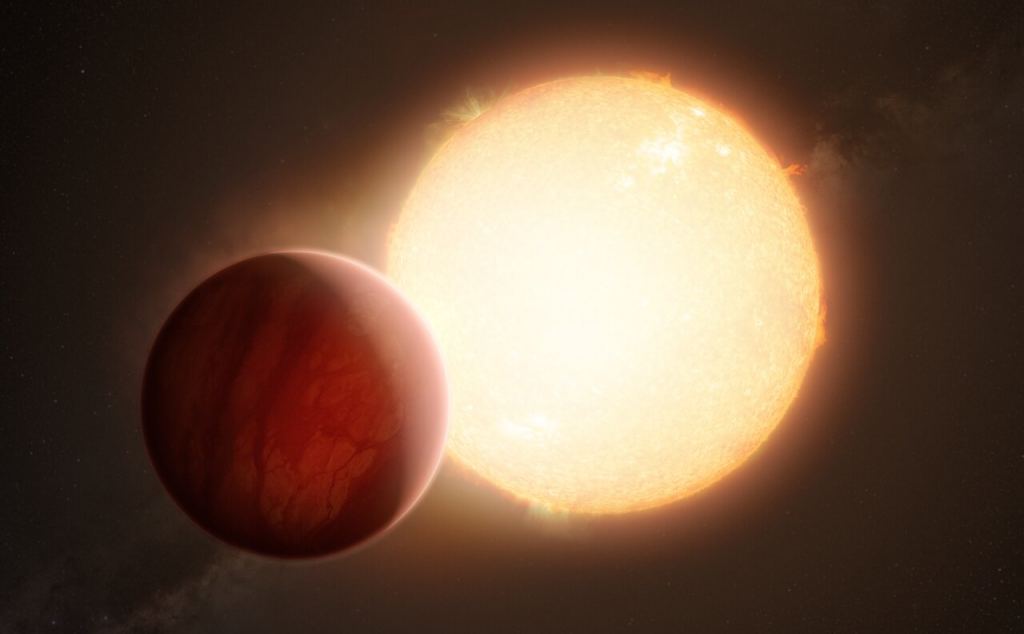
The study of extrasolar planets has led to some astounding discoveries, many of which have defied the expectations of astronomers and challenged our notions about the forms planetary systems can take. For example, the discovery of Jupiter-sized planets that orbit closely to their stars (“Hot Jupiters”) defied what astronomers suspected about gas giants. Previously, the general consensus was that gas giants form beyond the “Frost Line” – the boundary beyond which volatile elements (like water) freeze solid – and remain there for the rest of their lives.
Interestingly, this will happen when our Sun leaves its main sequence phase and enters its Red Giant Branch (RGB) phase. This raises the question of what happens to Hot Jupiters when their parent stars expand to become Red Giants. Using advanced 3D simulations, a team of researchers led by the Compact Object Mergers: Population Astrophysics and Statistics (COMPAS) consortium simulated how red giants will expand to engulf Hot Jupiters. Their findings could answer another mystery confronting astronomers, which is why some binary systems have one rapidly-rotating star with strange chemical compositions.
The research was led by Mike Lau, a Ph.D. student at Monash University’s School of Physics & Astronomy, and other members of the COMPAS consortium, a collaborative effort to study the evolution of binary systems. They were joined by members of The ARC Centre of Excellence for Gravitational Wave Discovery (OzGrav), the Flatiron Institute’s Center for Computational Astrophysics, Princeton University, and the Harvard & Smithsonian Center for Astrophysics (CfA). Their paper, “Hot Jupiter engulfment by a red giant in 3D hydrodynamics,” recently appeared in the Monthly Notices of the Royal Astronomical Society.

As Lau explained to Universe Today via email, the topic of Hot Jupiter engulfment is of interest to astrophysicists because they believe it may explain some of the “odd” stars that have been observed in our galaxy – rapidly rotating and chemically enriched giant stars. The recent explosion in exoplanet discoveries has allowed for various theories to be tested, including the possibility that when stars expand to become Red Giants, planets that used to orbit at a safe distance will spiral toward the star’s center, stirring up stellar material in the process. Said Lau:
“This is, therefore, one way of explaining observed rapidly rotating giant stars. Also, any planetary material that comes off during the in-spiral could alter stars’ surface chemical makeup. This may help us understand why a small fraction of stars are observed to be abnormally rich in lithium. Finally, we may be able to directly detect this process by looking for stars that have swollen up and brightened from eating a planet, though we will have to be very lucky to catch them in the act.“
The ability to directly observe engulfments and the resulting effect on stars will be possible thanks to next-generation space telescopes like the James Webb and ground-based telescopes with 30-meter (~98 ft) primary mirrors. This includes the Extremely Large Telescope (ELT), the Giant Magellan Telescope (GMT) – both of which are under construction in the Atacama desert in Chile – and the Thirty Meter Telescope (TMT), currently being built on Mauna Kea, Hawaii. Using a combination of adaptive optics, coronographs, and spectrometers, these observatories will be able to directly detect exoplanets orbiting close to their stars.

In the meantime, Lau and his colleagues conducted a series of 3D hydrodynamic simulations that recreated the engulfment process. As he described it:
“We used a method called smoothed particle hydrodynamics. This represents the giant star and hot Jupiter as collections of particles that follows the fluid’s motion, like a ball pit but with millions of balls. This technique has also been used to visualise fluids in video games and animations. A key result from our simulation is that the hot Jupiter may lose most of its material due to friction as it spirals into the star.”
In the future, Lau and his colleagues hope that further advances in computing will allow for higher-resolution simulations. If confirmed, their results could account for rapidly-rotating stars with abnormal chemical makeups in binary systems. They also offer a preview of what future surveys will show when they examine these systems and their exoplanets and can obtain spectra from them directly.
Further Reading: arXiv
The post What Happens to Hot Jupiters when their Star Becomes a Red Giant? appeared first on Universe Today.





More Stories
Will Triton finally answer, ‘Are we alone?’
SLS Hurricanes, James Webb Fixed, Strange Quark Star
This Nearby Dwarf Galaxy has Been a Loner for Almost the Entire age of the Universe